Wednesday, August 09, 2006
BAHA
Bone Anchored Hearing Aidsdid not know about them till i got here. siguro nakatulog na naman ako during lectures! =p. so what are they really?
What is a Baha? 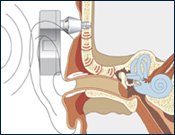 The Baha is a surgically implantable system for treatment of hearing loss that works through direct bone conduction. It has been used since 1977, and was cleared by the FDA in 1996 as a treatment for conductive and mixed hearing losses in the United States. In 2002, the FDA approved its use for the treatment of unilateral sensorineural hearing loss.
The Baha is a surgically implantable system for treatment of hearing loss that works through direct bone conduction. It has been used since 1977, and was cleared by the FDA in 1996 as a treatment for conductive and mixed hearing losses in the United States. In 2002, the FDA approved its use for the treatment of unilateral sensorineural hearing loss.
 The Baha is a surgically implantable system for treatment of hearing loss that works through direct bone conduction. It has been used since 1977, and was cleared by the FDA in 1996 as a treatment for conductive and mixed hearing losses in the United States. In 2002, the FDA approved its use for the treatment of unilateral sensorineural hearing loss.
The Baha is a surgically implantable system for treatment of hearing loss that works through direct bone conduction. It has been used since 1977, and was cleared by the FDA in 1996 as a treatment for conductive and mixed hearing losses in the United States. In 2002, the FDA approved its use for the treatment of unilateral sensorineural hearing loss. Baha is used to help people with chronic ear infections, congenital external auditory canal atresia and single sided deafness who cannot benefit from conventional hearing aids. The system is surgically implanted and allows sound to be conducted through the bone rather than via the middle ear - a process known as direct bone conduction.
How does a Baha work?
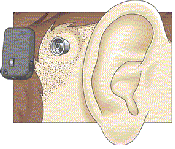 The Baha consists of three parts: a titanium implant, an external abutment, and a sound processor. The system works by enhancing natural bone transmission as a pathway for sound to travel to the inner ear, bypassing the external auditory canal and middle ear. The titanium implant is placed during a short surgical procedure and over time naturally integrates with the skull bone. For hearing, the sound processor transmits sound vibrations through the external abutment to the titanium implant. The vibrating implant sets up vibrations within the skull and inner ear that finally stimulate the nerve fibers of the inner ear, allowing hearing.
The Baha consists of three parts: a titanium implant, an external abutment, and a sound processor. The system works by enhancing natural bone transmission as a pathway for sound to travel to the inner ear, bypassing the external auditory canal and middle ear. The titanium implant is placed during a short surgical procedure and over time naturally integrates with the skull bone. For hearing, the sound processor transmits sound vibrations through the external abutment to the titanium implant. The vibrating implant sets up vibrations within the skull and inner ear that finally stimulate the nerve fibers of the inner ear, allowing hearing.
 The Baha consists of three parts: a titanium implant, an external abutment, and a sound processor. The system works by enhancing natural bone transmission as a pathway for sound to travel to the inner ear, bypassing the external auditory canal and middle ear. The titanium implant is placed during a short surgical procedure and over time naturally integrates with the skull bone. For hearing, the sound processor transmits sound vibrations through the external abutment to the titanium implant. The vibrating implant sets up vibrations within the skull and inner ear that finally stimulate the nerve fibers of the inner ear, allowing hearing.
The Baha consists of three parts: a titanium implant, an external abutment, and a sound processor. The system works by enhancing natural bone transmission as a pathway for sound to travel to the inner ear, bypassing the external auditory canal and middle ear. The titanium implant is placed during a short surgical procedure and over time naturally integrates with the skull bone. For hearing, the sound processor transmits sound vibrations through the external abutment to the titanium implant. The vibrating implant sets up vibrations within the skull and inner ear that finally stimulate the nerve fibers of the inner ear, allowing hearing.Who is a Candidate for the Baha System?
The Baha is used to rehabilitate people with conductive and mixed loss hearing impairment. This includes people with chronic infection of the ear canal, people with absence of or a very narrow ear canal as a result of a congenital ear malformation, infection, or surgery, and people with a single sided hearing loss as a result of surgery for a vestibular schwannoma (a tumor of the balance and hearing nerves).
The Baha is used to rehabilitate people with conductive and mixed loss hearing impairment. This includes people with chronic infection of the ear canal, people with absence of or a very narrow ear canal as a result of a congenital ear malformation, infection, or surgery, and people with a single sided hearing loss as a result of surgery for a vestibular schwannoma (a tumor of the balance and hearing nerves).
Chronic Ear Infection
Treatment for hearing losses with the Baha is suitable for people with a conductive or mixed hearing impairment caused by a chronic infection of the middle or outer ear that results in a persistent and unpleasant discharge. The first goal, of course, is to manage the infection. In rare cases, chronic infections fail to respond to treatment, but are determined to be non-threatening. In other cases, infections respond to treatment, but recur with use of a conventional in-the-canal hearing aid. When a hearing aid is placed in a susceptible ear canal, a chronic or recurrent infection may be aggravated by the obstruction of the canal and the resulting excessive humidity and lack of drainage. In these cases, the Baha may be a good solution for hearing rehabilitation.
The Baha sound processor transmits sound directly to the hearing nerve without involving the ear canal. With Baha there is no occlusion of the ear canal to aggravate infection. A Baha sound processor offers sound quality at least as good as a conventional air conduction device. For those who need high levels of amplification, problems related to feedback and discomfort are usually resolved.
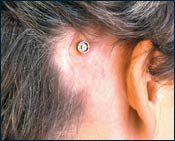
Treatment for hearing losses with the Baha is suitable for people with a conductive or mixed hearing impairment caused by a chronic infection of the middle or outer ear that results in a persistent and unpleasant discharge. The first goal, of course, is to manage the infection. In rare cases, chronic infections fail to respond to treatment, but are determined to be non-threatening. In other cases, infections respond to treatment, but recur with use of a conventional in-the-canal hearing aid. When a hearing aid is placed in a susceptible ear canal, a chronic or recurrent infection may be aggravated by the obstruction of the canal and the resulting excessive humidity and lack of drainage. In these cases, the Baha may be a good solution for hearing rehabilitation.
The Baha sound processor transmits sound directly to the hearing nerve without involving the ear canal. With Baha there is no occlusion of the ear canal to aggravate infection. A Baha sound processor offers sound quality at least as good as a conventional air conduction device. For those who need high levels of amplification, problems related to feedback and discomfort are usually resolved.

Congenital Hearing Loss
Congenital conductive hearing loss caused by a malformation of the middle or external ear resulting in a missing or incomplete ear canal (external auditory canal atresia) are effectively managed with a Baha. Traditionally people with this type of hearing loss have been offered an old-fashioned bone conducting hearing aid. These are either held on the head using a steel spring headband or included in the frame of a pair of glasses. Traditional bone conductors have several disadvantages. The sound quality is poor as the skin acts as a barrier for the sound to travel to the inner ear. They are uncomfortable - patients complain of pain and headaches due to the constant pressure of the headband. They are also cumbersome, obtrusive and insecure.
Congenital conductive hearing loss caused by a malformation of the middle or external ear resulting in a missing or incomplete ear canal (external auditory canal atresia) are effectively managed with a Baha. Traditionally people with this type of hearing loss have been offered an old-fashioned bone conducting hearing aid. These are either held on the head using a steel spring headband or included in the frame of a pair of glasses. Traditional bone conductors have several disadvantages. The sound quality is poor as the skin acts as a barrier for the sound to travel to the inner ear. They are uncomfortable - patients complain of pain and headaches due to the constant pressure of the headband. They are also cumbersome, obtrusive and insecure.
The Baha system can be a real solution for people with this type of impairment. The Baha sound processor is directly integrated to the skull bone. Because of this direct interface, the Baha offers significantly better sound quality than that of a traditional bone conductor. The Baha sound processor works without pressure on the skin avoiding the headaches and soreness associated with the conventional bone conductor. Baha offers excellent wearing comfort and a better aesthetic result.
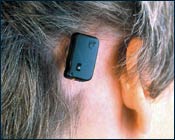 Baha for Unilateral Deafness
Baha for Unilateral DeafnessOne ear does not provide adequate hearing in many situations. Patients with severe hearing loss on one side, but normal hearing in the other ear have difficulty understanding speech in background noise (such as group conversations and restaurants) and determining which direction sound comes from. Unilateral deafness can result from viral infections, trauma, acoustic neuromas and other ear tumors and ear surgery.
Until recently, the best available approach for providing help in this situation has been the CROS (contralateral routing of offside signal) hearing aid. This technique utilized hearing aid microphones worn in both ears and routed sound from the deaf ear to the hearing ear. Unfortunately, most patients were unsatisfied with this system. Common complaints include the cosmetic appearance and discomfort of the headband, and the use of a hearing aid mold in the good ear. Most patients felt the benefit from the device is not worth the disadvantages.
The Baha, now an FDA cleared solution for unilateral deafness, provides a completely unique benefit. The Baha device is placed on the side of the deaf ear, transfers sound through bone conduction, and stimulates the cochlea of the normal hearing ear. The Baha effectively transmits sounds from the bad side to the normal ear and ultimately results in a sensation of hearing from a deaf ear. Stereo hearing results in improved understanding of speech, especially in background noise and aids in the localization of sound.
The Baha offers significant advantages to the traditional CROS hearing aid. The device is placed behind the ear leaving the canal open. It is worn under the hair and is not perceptible to others. Because it is held in place by a clip and directly integrated with the skull bone, there is no need for a head band and pressure against the skin of the head. In recent clinical trials patients prefer the sound and speech clarity achieved with the Baha verses the CROS and verses the unaided condition.
taken from UMMC website
The Baha offers significant advantages to the traditional CROS hearing aid. The device is placed behind the ear leaving the canal open. It is worn under the hair and is not perceptible to others. Because it is held in place by a clip and directly integrated with the skull bone, there is no need for a head band and pressure against the skin of the head. In recent clinical trials patients prefer the sound and speech clarity achieved with the Baha verses the CROS and verses the unaided condition.
taken from UMMC website
Posted by QT at 8/09/2006 10:56:00 am
Thursday, August 03, 2006
Cros/Bicros Aids
these aids are usually used if the patient has unilateral or asymmetric hearing loss. we don't fit much of these pero lately, it's getting more frequent. hmmn..what could have caused their unilateral/asymmetric losses - acoustic neuroma? middle ear problems? noise induced (like shooting on one side, gunfire)? trauma? vascular? the list goes on...
usually, hearing goes down at the same time on both ears. but if that is not the case, at least there's still another option. it might not be the best solution but at least, these may help.... it's not easy fitting these, u know? well, it's easy fitting them, technically. but getting the patients to wear a cord round the back of their head, getting them used to the idea that they have a microphone on one ear that will transmit sound to the other is a bit too much to take in. lalo na kung vain sila!
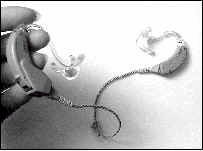

what you need: hearing aid, shoe, satellite microphone (looks like an aid) and cord.
anyways, these should explain more:
CROS/BiCROS hearing aids as defined by RNID.
(CROS - contralateral routing of signal)
These are for people with hearing in one ear only. CROS hearing aids pick up sound from the side with no hearing and feed it to the ear with normal or near normal hearing. BiCROS aids are similar but made for people with no useful hearing in one ear and some hearing loss in the other, so they make the sounds louder as well.
CROS/BiCROS as defined by NDCS
People with a profound unilateral deafness may benefit from a special type of hearing aid known as a CROS aid. Although it is described as a hearing aid, a CROS aid does not amplify sound. It simply transfers sound from the ear with deafness to the ear with hearing. The main advantage of using a CROS aid is that it can help the person to hear sounds from all directions.A CROS aid includes two units which both look like ordinary behind the ear hearing aids. However, the unit worn on the ear with deafness just contains a microphone. It is connected to the other unit, sometimes using a lead and sometimes using a wireless radio link. The patient listens to the sounds picked up by the microphone through the second unit, which they wear on their ear with hearing.BiCROS aids are used when there is no useful hearing in one ear and the other has some deafness. Sounds from a microphone on the side where there is no useful hearing are fed into the aid which amplifies sound for the better ear.
Posted by QT at 8/03/2006 10:03:00 am
Friday, June 09, 2006
CAPD
central auditory processing disorder
we would often use this as an excuse for not hearing so well. it has become one of our private jokes na nga. i mean, our audios show normal hearing but you would be surprised at the number of times we manifest "hearing loss" or siguro more aptly, "maling pagkakaintindi". uy ha, nd naman kami ganun ka-slow! =p i, myself, often wonder why i'm not hearing so well, inspite of being close to the speaker. there are times i would answer off topic - kakahiya! buti na lang we all 'understand' each other kasi all of us, one way or another, tends to 'drift away' from the conversation =p.
it came back to mind when celine mentioned that ust will have a conference (or seminar?) on this topic end of this year (end of november ata). speakers will be from the US. i will try to attend, cpd din to! haha! but this is truly one interesting topic. i hope i can find the time - amidst wedding preps and family-time.
**************************************************
taken from wikipedia:
Auditory Processing Disorder (APD) (previously known as "Central Auditory Processing Disorder" (CAPD)) is not a hearing impairment (i.e., a person with APD usually has nothing wrong with his or her ears), but an inability to process what is heard. (akong ako ata ito ah! - or is it just i don't want to listen, as in selective hearing? =p)
Aspects of auditory processing which may be affected by APD include "auditory discrimination", the ability to distinguish between similar sounds or words; "auditory figure-ground", the ability to distinguish relevant speech from background noise; and "auditory memory", the ability to recall what was heard.
Read more from: TSBVI (overview of assessment and management practices)
Posted by QT at 6/09/2006 09:09:00 pm
Wednesday, May 24, 2006
O.T
erick and i were asked by our manager if we want to commit ourselves to 6 months overtime. it's not a lot really as it's only once a week, for about 3 hours with 1 1/2 pay. not bad, that would help cover some 'holiday' costs. *lol*
it would, however, be in lymington hospital (45minutes from our main office, 30minutes from home). we'll do it on a monday. so i'll be coming from hythe (another outstation) with 30minutes travel time. i'll be hitching a ride home with erick. i'll probably be home around 9:30pm.
is it all worth it? considering taxes, travel, time? we'll see....
Posted by QT at 5/24/2006 09:14:00 am
Wednesday, May 17, 2006
NAL-NL1
this is the fitting method we are using in the department. it stands for national acoustics labs, non-linear, version 1.
The NAL-NL1 fitting procedure aims to provide the gain-frequency response that maximizes speech intelligibility while keeping overall loudness at a level no greater than that perceived by a normal-hearing person listening to the same sound. The calculations of speech intelligibility are based on extensive NAL research into how audibility relates to intelligibility. (NAL)
i must have been zzzzz-ing again when this was discussed in class *lol*
coming to england, i was bombarded with a lot of hearing aid stuff which i was so scared to tackle back in pinas. mahal kasi ng hearing aids dun so i'd rather not mess with it - ala pa naman akong pambayad pag nasira ko un (i would need my whole year salary in pinas to pay for a digital one!). grabe noh!
anyways, coming to england made me forget (little by little) most of the stuff i love doing - objective assessments (abr, eng). pano nd masyado napa-practise dito. hmmph! not to worry naman, i would only need to read up and update myself with what's new so i don't get left behind. and on the bright side, our department does all those objective assessments naman and they are using the same equipments we have back in pinas. so i just need to bid my time. hihihi!
come to think of it, i am now equipped with more knowledge (and skills) than i would have hoped for (rather, more than what my small brain could have absorbed =p).
this blog should be about nal-nl1 so, for more information, click here.
other fitting rationales can be found here (am not promoting bernafon, though. self explanatory ksi ung descriptions nila =p)
Posted by QT at 5/17/2006 10:51:00 am
Sunday, May 14, 2006
REMs
 or real ear measurements..
or real ear measurements..it's a standard procedure in our department to ensure optimal fitting of hearing aids to prescription targets based on the program set by MHAS (Modernising Hearing Aid Services).
i honestly did not know much about it (i was probably Zzzzzz-ing during lectures! =p) till i came here in uk to work. i think it's more because we didn't get to fit much aids in pinas. most of the patients that came my way were for diagnosis and when they needed rehabilitation, they're passed on to my colleague (and good friend) hubert up at the centre for audiological sciences.
i also blame it on the fact that hearing aid fits (esp. digital aids) were scarce as there are only a handful who can afford them. man, they're expensive! also, the probe tips that we used during practicals were so thick, i wouldn't have them inserted in my own ears! just so scared im gonna bust the pt's. tm with it.
but coming here, i was 'forced' to learn it by heart (have i?). i can certainly do it with eyes closed (well..just an exaggeration *lol*). anyways, what is it really and why do we have to do it?
What?
REMs allow your audiologist to evaluate the function of your hearing aids while you are wearing them. This evaluation guides your audiologist in making the necessary adjustments to assure optimal amplification.The shapes and sizes of everyone's ears, ear canals and head are quite different, and the degree and type of hearing loss varies from individual to individual. As a result, identical hearing aids may function quite differently in one person's ear than on another person's ear.
How?
To perform REM, your audiologist will place a tiny microphone into your ear canal. Sounds are then presented to the open ear to measure the effects of your open ear canal on the sound. Your hearing aid is then inserted and measures are made of the same exact sound in your ear canal with the aid in place. The difference between the two measurements is called the real-ear insertion gain of your hearing aid. It tells your audiologist a great deal about the quality of the sound you are receiving.
Once the real-ear insertion gain of your hearing aid is known, it can be compared to widely used amplification prescriptions, such as the National Acoustic Laboratories-Revised (NAL-R) prescription, the Libby prescription, or the Prescription of Gain and Output (POGO). ****In our case, we use NAL-NL1****
Why?
If there are differences in the prescribed sound quality and the measured sound of the aid, your audiologist can make necessary adjustments and take new measurements to fine-tune your hearing aid to provide the best possible sound, and therefore, the most possible benefit.
from: ACA (audiological consultants of atlanta)
a more detailed explanation of REMs can be found here
so, whatdyathink? =p
Posted by QT at 5/14/2006 02:16:00 pm
Wednesday, May 10, 2006
Radio Aids
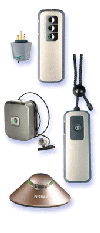 A radio hearing aid effectively 'reduces' the distance between the speaker and the deaf child, whether that speaker is a parent, teacher or anyone in communication with the child. In the usual post-aural hearing aid the microphone is close to the ear of the person wearing the aid. As we have said, this microphone picks up and amplifies all background noise as well as speech. It cannot discriminate between the two. The microphone on a post aural hearing aid becomes less and less effective as the distance between the speaker and the child increases.
A radio hearing aid effectively 'reduces' the distance between the speaker and the deaf child, whether that speaker is a parent, teacher or anyone in communication with the child. In the usual post-aural hearing aid the microphone is close to the ear of the person wearing the aid. As we have said, this microphone picks up and amplifies all background noise as well as speech. It cannot discriminate between the two. The microphone on a post aural hearing aid becomes less and less effective as the distance between the speaker and the child increases. In a radio aid the microphone is separated from the hearing aid and given to the speaker. The subsequent link between the microphone and the receiver on the child's ear is via radio waves.This means that the distance between the spoken word and the microphone is close and constant and there is less opportunity for background noise to be picked and therefore interfere with the speech sounds. The signal transmitted to the hearing aid remains at a constant level regardless of the distance between the speaker and the child.
For these reasons radio aids are particularly beneficial to deaf children in classrooms where there is a lot of background noise. They are also useful outside where the distance between speaker and the child may be greater.
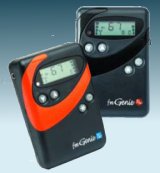
They do have many advantages over post-aural hearing aids, as described earlier, but still they remain an aid to hearing and do not return the hearing to normal.
additional info at: national deaf children's society





